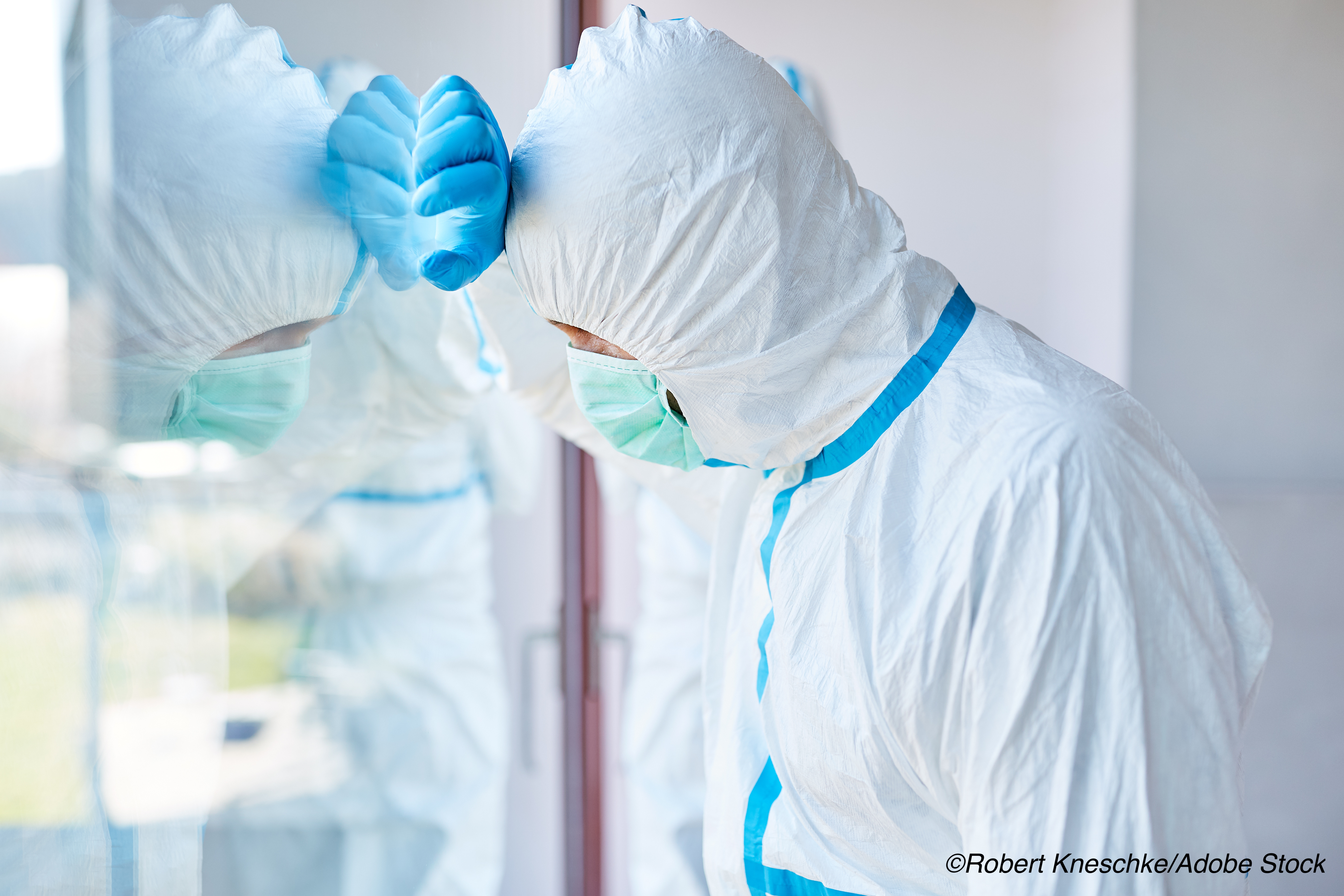Patient-to-health-care worker transmission of SARS-CoV-2 was found to be low in the ICU of a large, academic hospital in London during the early months of the Covid-19 outbreak, with infections among critical care workers more likely to result from community exposures or exposures occurring in other areas of the hospital, researchers reported.
Critical care workers are considered at high risk for Covid-19 infection, but findings from a cross-sectional study of ICU staff infections at King’s College Hospital, London, during the first wave of the Covid-19 pandemic suggest that use of personal protective equipment (PPE) was largely effective for protecting staffers, according to lead researcher Kate El Bouzidi, MD, and Kings College colleagues.
El Bouzidi presented the study findings by video this week at a late breaking research session to the Society of Critical Care Medicine (SCCM) 50th Critical Care Congress, which was held virtually.
The study was one of several addressing Covid-19 in the ICU presented at late breaker sessions.
A separate study examining ICU staff burnout during a high Covid-19 admission period at two academic hospitals in the Netherlands found significantly higher levels of physician and nurse burnout compared to the pre-Covid period from October through December, 2019.
Physicians were more than three times more likely than nurses to report new burnout symptoms directly related to Covid-19 when surveyed during the post-peak period from May to June 2020, according to lead researcher Niek Kok, MSc, of Radbound University Medical Center, The Netherlands.
Both studies were published in the SCCM journal Critical Care Medicine simultaneous with their presentation at SCCM.
In the ICU worker infection study STOICS (Serological Testing of Intensive Care Staff), investigators examined the correlation between antibody status, previous swab testing and symptoms among staffers, and they also explored the temporal relationship between staff symptom onset and Covid-19 patient admissions.
Kings College Hospital critical care department is one of the largest in the United Kingdom, with 69 beds in 4 ICUs. During the first wave of the Covid-19 outbreak, the critical care department was increased to 205 beds in 13 clinical areas.
Between March and April of 2020, approximately 2,000 Covid-19 admissions occurred, including roughly 180 critical care admissions.
“Many staff were redeployed during this period, and we estimated that more than 800 people were deployed to critical care areas,” El Bouzidi said, adding that adequate PPE was available throughout the period.
The cross-sectional study included staff working in the critical care unit during a three-day period in April of 2020 who were asked to complete a detailed questionnaire and provide a serum sample which was tested for SARS-CoV-2 antibodies.
The researchers compared the timing of symptoms in staff to Covid-19 patient admissions to critical care and they identified factors associated with antibody detection.
Of 625 staffers who participated in the study, 384 (61.4%) reported previous symptoms and 124 (19.8%) had previously sent a swab for testing. Severe acute respiratory syndrome coronavirus-2 infection had been confirmed in 37 of those swabbed (29.8%).
One-in-five (21%) staffers had detectable SARS-CoV-2 antibody, including 9.9% who had been asymptomatic.
The peak onset of symptoms among staff occurred 2 weeks before the peak in Covid-19 patient admissions.
Staffers who worked in multiple departments across the hospital were more likely to be seropositive, as were those with a symptomatic household contact (31.3%, compared with 16.2% seropositivity in staffers without a positive household contact (P<0.0001).
“We believe that PPE in the ICU was largely effective in preventing transmissions from patients and that staff infections were more likely acquired away from the bedside,” El Bouzidi said, adding that the findings highlight the need to maintain rigorous protective measures in all areas of the hospital.
“Risk can be mitigated somewhat by staggering breaks and holding virtual meeting and handovers, which most of us are doing already,” she said.
El Bouzidi concluded that the findings could be used to inform structural approaches to future pandemic management by highlighting the need for designing spaces that enable social distancing throughout the hospital setting.
The ICU burnout study included 5 ICUs based at a single university medical center in the Netherlands and another single ICU at a separate teaching hospital.
In his presentation, researcher Niek Kok noted that the study was unique because it included data on ICU professional burnout in the months prior to the Covid-19 pandemic.
A total of 233 physicians and nurses completed baseline surveys exploring burnout in October and December of 2019, followed by surveys sent in May through June of 2020. Nurses made up 79% of the survey cohort, and physicians made up 21%.
The prevalence of burnout symptoms was 23.0% in the pre-Covid-19 survey and 36.1% at post-peak time, with higher rates in nurses (38.0%) than physicians (28.6%).
Physicians were more likely than nurses, however, to develop burnout symptoms directly related to Covid-19 (odds ratio, 3.56; 95% CI, 1.06-12.21).
Among the most significant contributors to moral distress in the Covid-19 post-peak period was lack of time, working with colleagues perceived to be not skilled enough, and working with colleagues whose actions were perceived as unsafe.
During the Covid-19 peak-treatment period, the recruitment of medical personnel from outside of critical care units appeared to be a significant contributor to stress among those who regularly worked in ICUs, Kok said.
- Patient-to-health-care worker transmission of SARS-CoV-2 was found to be low in the ICU of a large, academic hospital in London during the early months of the Covid-19 outbreak.
- Infections among critical care workers were more likely to result from community exposures or exposures occurring in other areas of the hospital.
Salynn Boyles, Contributing Writer, BreakingMED™
Funding for the study by Kok and colleagues was provided by ZonM, the Netherlands Organization for Health Research and Development, and the Dutch Cancer Society. The researchers reported no other disclosures.
Funding for the STOIC study was provided by the Medical Resarch Council and U.K. Research and Innovation. Several resarchers declared a financial interest in the Imperial Hybrid double antigen binding assay (DABA).
Cat ID: 353
Topic ID: 79,353,730,933,353,926,192,927,151,928,925,934,347


